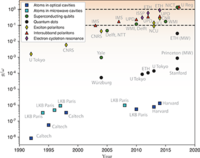当前位置:
X-MOL 学术
›
Rev. Mod. Phys.
›
论文详情
Our official English website, www.x-mol.net, welcomes your feedback! (Note: you will need to create a separate account there.)
Ultrastrong coupling regimes of light-matter interaction
Reviews of Modern Physics ( IF 44.1 ) Pub Date : 2019-06-07 , DOI: 10.1103/revmodphys.91.025005 P. Forn-Díaz , L. Lamata , E. Rico , J. Kono , E. Solano
Reviews of Modern Physics ( IF 44.1 ) Pub Date : 2019-06-07 , DOI: 10.1103/revmodphys.91.025005 P. Forn-Díaz , L. Lamata , E. Rico , J. Kono , E. Solano

|
Recent experiments have demonstrated that light and matter can mix together to an extreme degree, and previously uncharted regimes of light-matter interactions are currently being explored in a variety of settings. The so-called ultrastrong coupling (USC) regime is established when the light-matter interaction energy is a comparable fraction of the bare frequencies of the uncoupled systems. Furthermore, when the interaction strengths become larger than the bare frequencies, the deep-strong coupling (DSC) regime emerges. This article reviews advances in the field of the USC and DSC regimes, in particular, for light modes confined in cavities interacting with two-level systems. An overview is first provided on the theoretical progress since the origins from the semiclassical Rabi model until recent developments of the quantum Rabi model. Next, several key experimental results from a variety of quantum platforms are described, including superconducting circuits, semiconductor quantum wells, and other hybrid quantum systems. Finally, anticipated applications are highlighted utilizing USC and DSC regimes, including novel quantum optical phenomena, quantum simulation, and quantum computation.
中文翻译:

光与物质相互作用的超强耦合机制
最近的实验表明,光和物质可以以极高的程度混合在一起,并且目前正在各种环境中探索以前未知的光-物质相互作用机制。当光物质相互作用能是未耦合系统的裸频率的可比部分时,便建立了所谓的超强耦合(USC)机制。此外,当相互作用强度变得大于裸频率时,就会出现深强耦合(DSC)机制。本文回顾了USC和DSC体制领域的进展,特别是限制在与两级系统交互作用的空腔中的光模式。首先概述了从半经典拉比模型的起源到量子拉比模型的最新发展以来的理论进展。下一个,描述了来自各种量子平台的几个关键实验结果,包括超导电路,半导体量子阱和其他混合量子系统。最后,利用USC和DSC机制突出了预期的应用程序,包括新颖的量子光学现象,量子模拟和量子计算。
更新日期:2019-06-07
中文翻译:

光与物质相互作用的超强耦合机制
最近的实验表明,光和物质可以以极高的程度混合在一起,并且目前正在各种环境中探索以前未知的光-物质相互作用机制。当光物质相互作用能是未耦合系统的裸频率的可比部分时,便建立了所谓的超强耦合(USC)机制。此外,当相互作用强度变得大于裸频率时,就会出现深强耦合(DSC)机制。本文回顾了USC和DSC体制领域的进展,特别是限制在与两级系统交互作用的空腔中的光模式。首先概述了从半经典拉比模型的起源到量子拉比模型的最新发展以来的理论进展。下一个,描述了来自各种量子平台的几个关键实验结果,包括超导电路,半导体量子阱和其他混合量子系统。最后,利用USC和DSC机制突出了预期的应用程序,包括新颖的量子光学现象,量子模拟和量子计算。



























 京公网安备 11010802027423号
京公网安备 11010802027423号